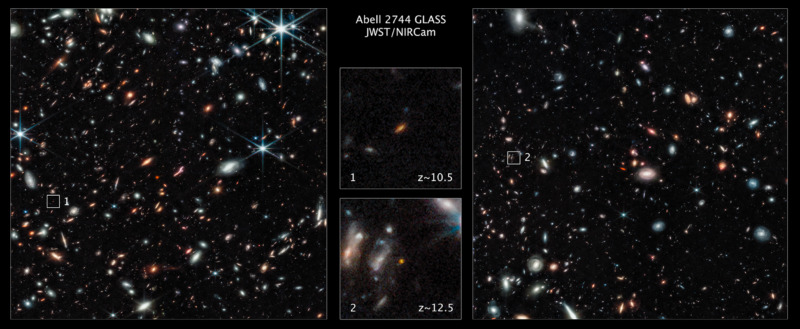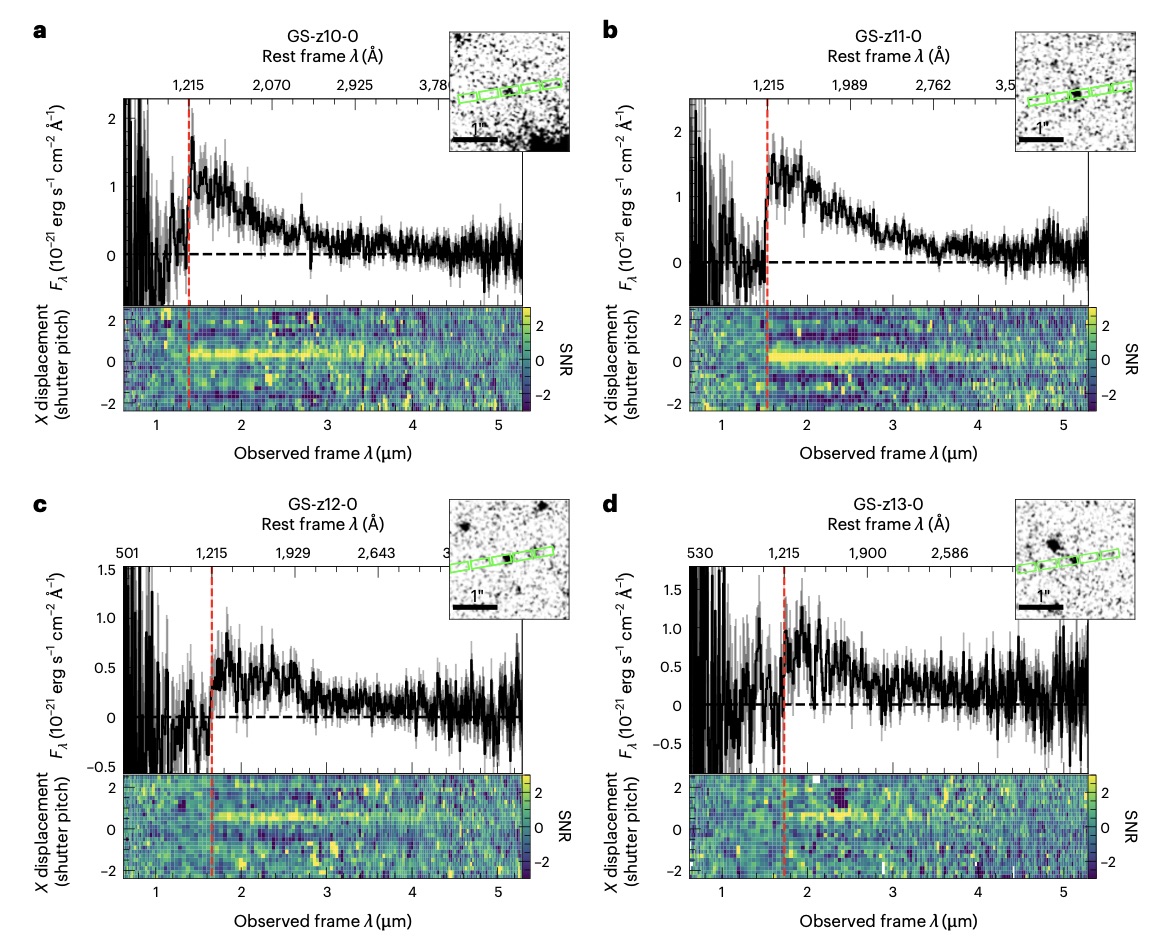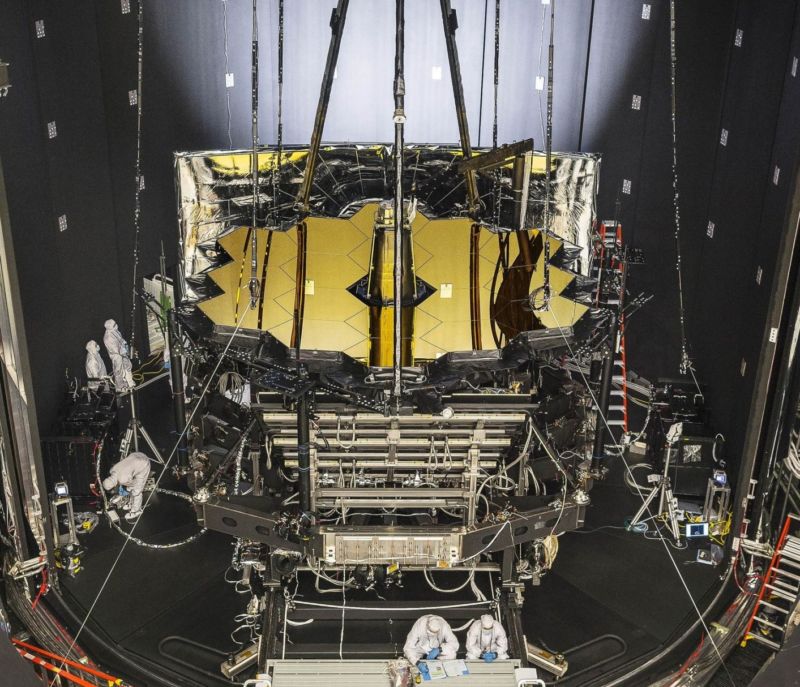
One of the goals of the Webb Space Telescope was imaging the earliest galaxies, giving us a new window into how our Universe evolved between the dense, hot material from the Big Bang and its star- and structure-filled present. And, almost as soon as the data started pouring in, things have looked very promising, with strong indications that we were picking up galaxies as they appeared only a few hundred million years after the Big Bang.
But a few uncertainties remained, as unusual conditions could potentially cause a much more recent galaxy to have features that make it look much older. That may be the case with a galaxy that would otherwise be the oldest ever detected.
On Tuesday, two papers were released that put the issue to rest, providing a full spectrum of four early galaxies and showing that they all clearly date from just a few hundred million years after the Big Bang. Imaging of the same galaxies shows that they're full of young stars that lack most of the heavier elements seen in today's Universe.
Full spectrum
Figuring out the age of early galaxies relies on finding a specific feature in the light the galaxies emit. Early in the Universe's history, most of it was filled with hydrogen atoms, which can absorb photons once they have sufficient energy to move its electron into other orbitals. Thus, although an early galaxy would emit broadly across the spectrum, there would be a sharp cutoff at what's called the Lyman break—any photons more energetic than that would be absorbed by the hydrogen.
Nearby, the Lyman break would reside in the UV portion of the spectrum. But its location gets red-shifted as photons travel across the expanding Universe, which stretches out the wavelength of light. As a result, the Lyman break travels across the entire visible spectrum and ends up in the infrared as we look further and, thus, earlier into the Universe's history. Finding the exact wavelength of the break can therefore tell us exactly how far the light traveled and how old the galaxy is.
The first papers that have come out on early galaxies relied on different filters that let in different areas of the infrared spectrum—researchers looked for galaxies that were present at longer wavelengths but disappeared at higher ones, suggesting that the Lyman Break was in the wavelengths let through by the lower-energy filter.
But this is a bit inexact, as the filters cover a range of wavelengths—we can't definitely know where within that range the break resides. And, by not capturing the details of the spectrum, it's possible we can miss information that indicates the feature we're seeing isn't actually the Lyman break, which could allow a closer galaxy to masquerade as something much more distant.
So, the new work uses the Webb's NIRSpec instrument to capture the full spectrum of a set of galaxies in a region of space that had earlier been imaged by the Hubble. The new papers focus on four of these: two previously identified by Hubble and two new from the Webb data.
Old and early
The spectra clearly show the Lyman break in all four of the spectra. The galaxies range in age from 460 million years after the Big Bang to just 325 million years after the Big Bang. The latter is the youngest galaxy ever to have its age confirmed through spectroscopy. (Though again, there are some indications that we've imaged some even closer to the Big Bang.) They're all also faint enough that we had never had an instrument that even could have obtained their spectra prior to putting the Webb in space.

What do these galaxies look like? They're relatively small, with about 108 to 109 times the mass of the Sun worth of stars. That makes them similar in size to the Small Magellanic Cloud, a dwarf galaxy in our local group. But they're forming stars at a pace that's roughly equivalent to the Milky Way's rate, which is about 10 times the rate of star formation in the Small Magellanic Cloud. So, star formation is occurring at a rapid pace.
The stars themselves appear to be extremely young, as well. Based on the imaging of the galaxies, about half the stars in them are less than 70 million years old—perhaps considerably less. There's also very little in the way of heavy elements around, which would have been generated by an even earlier generation of stars. At least one of the galaxies has less than 10 percent of the heavier elements seen in the Sun.
All of which is consistent with what we'd expect from the earliest galaxies in the Universe. And, critically, these properties are consistent with models of galaxy formation based on our current dark energy/cold dark matter model of cosmology—which you'd kind of expect, given that we had based galaxy formation models in part on the constraints of our understanding of cosmology.
That doesn't mean that cosmology is off the hook, though. There are still potentially earlier galaxies that need a more detailed look. There's also the matter of the frequency of the galaxies. Once we perform broader surveys of a region of space, it's possible that we'll find that more galaxies formed shortly after the Big Bang than we can account for.
Nature Astronomy, 2023. DOI: 10.1038/s41550-023-01918-w, 10.1038/s41550-023-01921-1 (About DOIs).



3175x175(CURRENT).thumb.jpg.b05acc060982b36f5891ba728e6d953c.jpg)

Recommended Comments
There are no comments to display.
Join the conversation
You can post now and register later. If you have an account, sign in now to post with your account.
Note: Your post will require moderator approval before it will be visible.